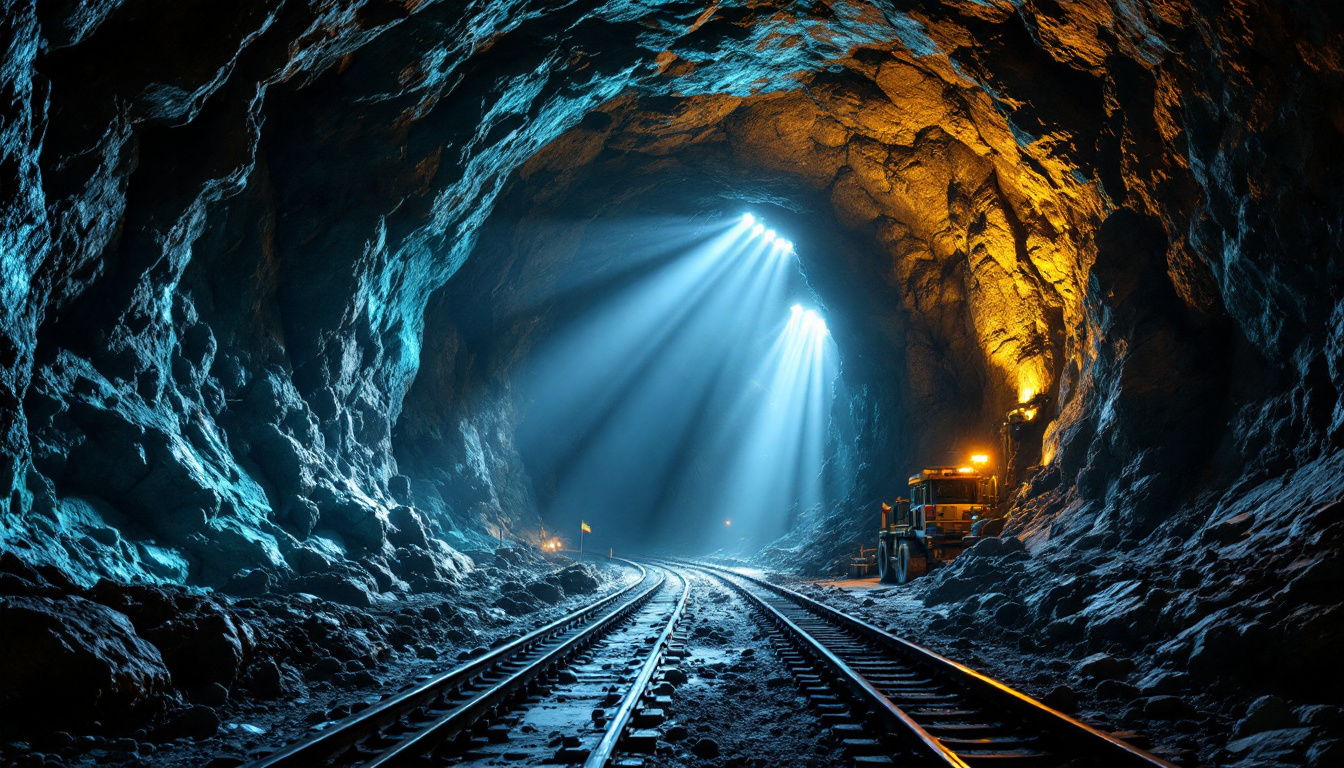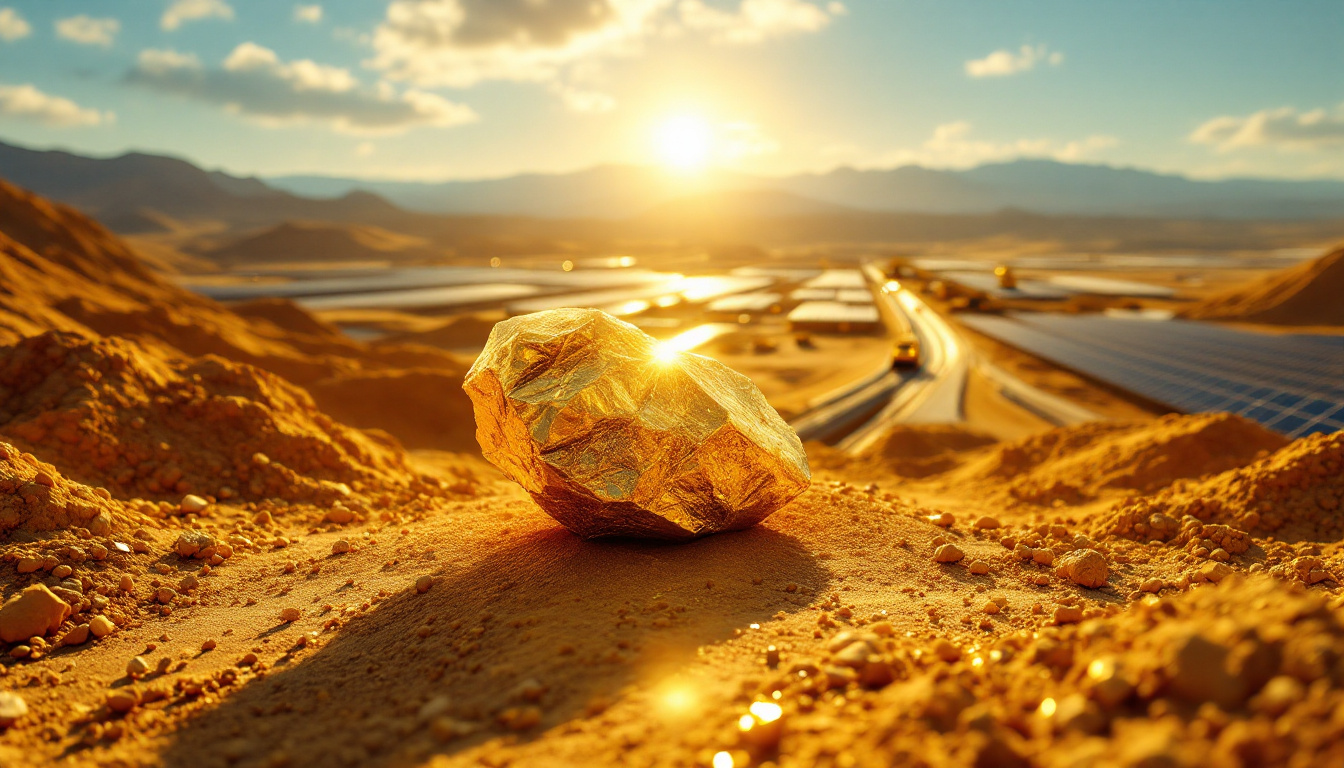Why Is Western Gallium Production Making a Comeback?
The global landscape for gallium production is undergoing a significant transformation as Western nations actively develop alternative supply chains to reduce their dependence on China. This strategic pivot represents a watershed moment in critical minerals energy transition, driven by both national security concerns and economic imperatives.
Western countries are investing in domestic gallium capabilities after decades of allowing production to concentrate in China. The catalyst for this revival has been China's export restrictions, which exposed the vulnerability of global technology supply chains and created both challenges and opportunities for miners and refiners outside China.
Rio Tinto has emerged as a front-runner in this space, demonstrating the potential for Western companies to establish viable gallium production. Meanwhile, junior mining companies are exploring new approaches that could fundamentally change how this critical mineral is sourced and processed.
What Makes Gallium a Strategic Critical Mineral?
The Technological Importance of Gallium
Gallium possesses unique properties that make it irreplaceable in modern technology. With its remarkably low melting point of 29.8°C (it literally melts in your hand) and exceptional semiconductor characteristics, gallium has become essential in applications ranging from everyday electronics to cutting-edge defense systems.
The mineral is a crucial component in:
- Semiconductor manufacturing – Gallium arsenide (GaAs) and gallium nitride (GaN) serve as foundation materials
- LED production – Enabling energy-efficient lighting and displays
- Solar cell technology – Improving efficiency in photovoltaic applications
- 5G infrastructure – Supporting high-frequency, high-power applications
- Defense systems – Powering radar, communications, and guidance systems
- Quantum computing – Emerging as a material for next-generation computing architecture
Its semiconductor properties are particularly valuable because gallium-based compounds can operate at higher frequencies, temperatures, and power levels than silicon-based alternatives, making them indispensable for technological advancement.
Market Growth Projections
The gallium market is poised for explosive growth in the coming decade:
- Current global market value (2024): US$2.45 billion
- Projected market value by 2028: US$5.38 billion
- Projected market value by 2034: US$21.53 billion
- Compound annual growth rate: 24.3%
This remarkable trajectory is driven by accelerating demand across multiple sectors, particularly in semiconductor applications for artificial intelligence, autonomous vehicles, and next-generation communications infrastructure.
China's Market Dominance
China currently controls approximately 98% of the global gallium supply chain. This near-monopoly position didn't develop by accident—it resulted from decades of strategic investment and policy support while Western producers gradually exited the market due to economic pressures.
Chinese producers extract gallium primarily as a by-product from two sources:
- The Bayer Process in alumina refining, where gallium is concentrated in waste streams
- Zinc processing operations, which yield smaller but still significant quantities
This dominance has given China extraordinary leverage over global technology supply chains, which it has recently begun to exercise through export restrictions.
How Did China's Export Restrictions Change the Gallium Market?
China's implementation of export controls on gallium in 2023-2024 sent shockwaves through global technology supply chains. The restrictions required Chinese exporters to apply for special permits to ship gallium products overseas, effectively creating a chokepoint in the global supply.
The market response was immediate and dramatic:
| Market Indicator | Pre-Restrictions | Post-Restrictions | Change |
|---|---|---|---|
| Price per kg | ~US$200 | ~US$900 | +350% |
| Supply security | Stable | Uncertain | Negative |
| Western investment | Limited | Accelerating | Positive |
This price volatility highlighted the market's extreme vulnerability to Chinese policy decisions and created a compelling economic case for alternative sources of supply. As James Durrant, Managing Director of RareX, observed: "Rio Tinto's move confirms non-Chinese supply has a real future… integration unlocks true project economics."
Strategic Response from Western Nations
The restrictions have catalyzed Western nations to develop alternative supply chains through multiple parallel approaches:
- Reviving dormant production capabilities in facilities that were mothballed when Chinese production made them uneconomical
- Exploring new extraction technologies that can produce gallium more efficiently or from different source materials
- Developing standalone gallium resources rather than relying solely on by-product production
- Investing in recycling and recovery systems to capture gallium from manufacturing waste and end-of-life products
The European Union has incorporated gallium into its Critical Raw Materials Act, while the United States has identified it as essential for both economic security and defense applications, creating policy frameworks to support domestic production. This approach has been further strengthened by the Trump critical minerals order, which emphasized securing domestic supply chains for strategic materials.
How Is Rio Tinto Leading the Western Gallium Revival?
Rio Tinto's Strategic Initiative
Rio Tinto has positioned itself at the forefront of Western gallium production with a comprehensive development plan that leverages its existing operations and technical expertise. The company's approach exemplifies how major miners can respond to critical mineral challenges.
Rio Tinto's gallium strategy includes:
- Initial R&D Success: Successfully produced gallium metal at lab scale in partnership with New York-based Indium Corporation
- Demonstration Plant: Planning a 3.5 tonnes per annum (tpa) facility at the Vaudreuil alumina refinery in Quebec
- Commercial Scale: Potential to scale up to 40 tpa, representing 5-10% of global demand
- Integration Advantage: Leveraging existing alumina refining infrastructure to create production efficiencies
This approach allows Rio Tinto to minimize capital costs by utilizing existing Bayer Process infrastructure while adding significant value to what would otherwise be waste streams. As Durrant notes, "Rio's scale and integration validate non-Chinese gallium's viability" in the global marketplace.
Historical Context: Australia's Previous Gallium Production
Rio Tinto's initiative isn't the first attempt at Western gallium production. Australia briefly participated in gallium production when France's Rhône-Poulenc operated a specialized facility near Pinjarra, Western Australia:
- Operational period: 1989-1990
- Investment scale: $50 million plant (equivalent to approximately $115 million today)
- Planned production capacity: 50 tpa
- Location: 4km from Alcoa's alumina refinery
- Reason for closure: Market oversupply caused price collapse
- Lesson learned: Production scale must align with market demand
This historical precedent offers important lessons for current developers. The Rhône-Poulenc plant was technically successful but economically unsustainable due to market conditions—a cautionary tale about the risks of oversupplying a relatively small market. Today's producers must carefully balance scale against projected demand.
What New Approaches Are Emerging for Gallium Production?
Standalone Gallium Mining Projects
One of the most significant developments in gallium production is the emergence of dedicated mining projects that target gallium as a primary product rather than a by-product. This represents a fundamental shift in how the industry approaches gallium resources.
Nimy Resources' Mons Project (Western Australia)
Nimy Resources is pioneering this approach with its Mons Project:
- Location: 370km northeast of Perth
- Exploration Target: 9.6-14.3Mt at 39-78ppm gallium
- Distinctive Feature: Gallium contained in chloritised schist
- Grade Advantage: Potential grades of 400-800ppm in chloritised schist (significantly higher than bauxite-derived gallium)
- Development Status: Drilling ongoing, targeting maiden resource in coming months
- Strategic Partnership: Collaboration with US-based M2i Global for potential Department of Defense supply
Luke Hampson, Managing Director of Nimy Resources, emphasized the project's disruptive potential: "Standalone gallium mining is viable with high-grade schist." The company's approach has been validated by CSIRO studies confirming chloritised schist's gallium enrichment potential.
These higher grades could transform the economics of gallium production. While traditional by-product recovery from alumina typically works with grades of 50-80ppm, Nimy's chloritised schist zones with up to 800ppm gallium represent potentially game-changing concentration levels, as reported by The Australian Financial Review.
Alternative Production Technologies
Beyond new mining approaches, innovative extraction methods are being developed to diversify gallium production pathways:
MTM Critical Metals' Flash Joule Heating Technology
MTM Critical Metals is developing a novel approach to gallium recovery:
- Process: Uses electrical current to flash joule heating to over 3000°K, vaporizing target metals as chlorides
- Feed Material: Processing scrap with 15-20% gallium content supplied by Indium Corporation
- Development Status: Planning 1 tonne per day demonstration plant in Chambers County, Texas
- Advantage: Domestic US processing capability, reducing supply chain vulnerabilities
This technology represents a potential paradigm shift in how gallium is recovered and refined. By focusing on high-concentration scrap rather than low-grade primary materials, MTM's approach could offer both economic and environmental advantages while establishing critical domestic processing capability in the United States.
Which ASX Junior Companies Are Pursuing Gallium Opportunities?
The gallium revival has attracted numerous Australian Securities Exchange (ASX) listed companies, each pursuing different approaches to capitalize on growing demand and supply constraints. These junior mining investments are exploring projects with varying geological contexts and development strategies.
Emerging Gallium Players on the ASX
| Company | Project | Key Highlights | Recent Results |
|---|---|---|---|
| RareX (ASX:REE) | Cummins Range | High-grade gallium intercepts in the Kimberley region | Some of the highest-grade gallium intercepts in Australian exploration history |
| Western Yilgarn (ASX:WYX) | Norcia | Gallium-bauxite project 25km north of Julimar West | 2m at 134.3g/t Ga₂O₃ from surface |
| Victory Metals (ASX:VTM) | North Stanmore | Gallium in mixed rare earth carbonate | Resource of 247.5Mt with 26ppm Ga₂O₃ (4,788t contained) |
| G50 Corp (ASX:G50) | Golconda | US-based gallium project | Early-stage exploration |
| Axel REE (ASX:AXL) | Caladão | Brazilian gallium-REE project | 15m at 60g/t Ga₂O₃, 6m at 75g/t Ga₂O₃ from surface |
Many of these companies are pursuing multi-element strategies where gallium adds value to projects primarily focused on other minerals. As Brendan Clark, CEO of Victory Metals, notes: "Gallium adds value without complicating rare earths recovery," suggesting that companies can enhance project economics without significantly increasing processing complexity.
This multi-element approach may prove particularly advantageous as it distributes risk across several commodity markets rather than relying solely on gallium's relatively small (though growing) market.
What Are the Challenges in Developing Western Gallium Supply?
Technical and Economic Hurdles
Despite the compelling strategic case for Western gallium production, developers face significant challenges:
- By-product Economics: Traditional gallium production as a by-product requires primary metal production to be economically viable, creating complex interdependencies
- Scale Requirements: Production facilities must achieve sufficient scale to be economical without oversupplying the market
- Processing Complexity: Extraction and purification to semiconductor-grade purity (>99.99%) require specialized technical expertise
- Capital Investment: Significant upfront investment needed for processing facilities
These technical challenges are compounded by market uncertainties. As Luke Hampson observes, "Scaling production without crashing prices is critical" for new entrants. The collapse of Rhône-Poulenc's Pinjarra operation in 1990 stands as a cautionary example of how quickly oversupply can undermine project economics.
Competitive Factors
Western producers also face established competition:
- Chinese Cost Advantage: Decades of experience and established infrastructure give Chinese producers significant cost efficiencies
- Market Volatility: Price fluctuations can undermine investment cases for new projects
- Technology Evolution: Changing end-use applications may alter demand patterns in ways that are difficult to predict
These competitive pressures create a challenging environment for new market entrants. However, the strategic importance of gallium in both commercial technology and defense applications provides some insulation against purely economic considerations.
What Does the Future Hold for Western Gallium Production?
Strategic Importance and Growth Potential
The outlook for Western gallium production is shaped by several converging factors that transcend simple supply-demand economics:
- Supply Chain Security: Western nations increasingly view domestic gallium production as essential for technological sovereignty and industrial resilience
- Defense Applications: Growing military applications create stable demand regardless of commercial market fluctuations
- Semiconductor Industry Growth: Expanding semiconductor manufacturing in the US and Europe will drive regional gallium demand
These factors create a supportive environment for Western production even if it cannot immediately match Chinese costs. The mining industry evolution continues to demonstrate how policy considerations can shape market development, and similar initiatives continue under current administrations worldwide.
Integration with Critical Minerals Strategy
Western gallium production is increasingly viewed as part of broader critical minerals strategies rather than in isolation:
- Multi-element Value: Projects combining gallium with other critical minerals may achieve better economics through diversification
- Processing Hubs: Regional processing centers may emerge to handle multiple critical minerals efficiently
- Government Support: Strategic minerals initiatives likely to provide funding and policy support for gallium projects
James Durrant of RareX articulates this integrated view: "Multi-element projects will dominate future economics" in the critical minerals landscape. This approach recognizes that while gallium's market may be relatively small, its strategic importance far outweighs its market size.
Featured Snippet Opportunity:
Gallium is experiencing a Western production revival led by Rio Tinto's 40 tpa Quebec project, with junior miners exploring high-grade deposits up to 800ppm—far richer than traditional alumina by-product sources. This strategic shift aims to counter China's 98% market dominance and respond to export restrictions that have driven prices from $200/kg to $900/kg since 2023.
FAQ: Western Gallium Production
How is gallium traditionally produced?
Gallium is typically extracted as a by-product from the Bayer Process in alumina refining and from zinc processing. In alumina refineries, gallium concentrates in certain waste streams during the processing of bauxite. Specialized equipment then extracts this gallium, followed by multiple purification steps to achieve the high purity levels required for semiconductor applications.
This by-product status has historically created barriers to entry for new market participants, as dedicated gallium production facilities are rare and economically challenging without the underlying primary metal production.
Why did China restrict gallium exports?
China implemented export controls on gallium as part of broader strategic measures to maintain technological advantage and leverage in trade negotiations. The restrictions require Chinese exporters to obtain special permits before shipping gallium products overseas, effectively allowing the government to control supply volumes.
These restrictions align with China's policy of using its dominance in critical minerals as geopolitical tools. By controlling gallium exports, China gains leverage in technology trade disputes and potentially slows Western development in advanced semiconductor manufacturing and defense applications.
Can recycling help address gallium supply issues?
Recycling represents a promising avenue for gallium recovery, particularly from electronic waste. However, current recovery rates remain low due to technical challenges and the dispersed nature of gallium in end products. The metal is typically used in small quantities across millions of devices, making collection and efficient recovery difficult.
Companies like MTM Critical Metals are developing innovative approaches to recover gallium from manufacturing waste streams, which contain much higher concentrations than end-of-life products. These manufacturing scraps with 15-20% gallium content offer more economically viable recycling opportunities than consumer electronic waste.
What applications drive gallium demand?
The primary demand drivers for gallium include:
- Gallium arsenide (GaAs) and gallium nitride (GaN) semiconductors for high-performance applications
- LED manufacturing for displays and lighting
- Solar cell production for high-efficiency photovoltaics
- 5G network infrastructure components
- Defense and aerospace applications including radar and communication systems
- Emerging quantum computing technologies
The fastest-growing segment is GaN semiconductors, which are increasingly used in power electronics for electric vehicles, data centers, and renewable energy systems due to their superior efficiency and thermal properties compared to traditional silicon.
How does gallium pricing work?
Gallium pricing is relatively opaque compared to other metals, with most transactions occurring through direct
Want to Identify the Next Major Mineral Discovery?
Discover how you can tap into significant investment opportunities with real-time alerts on ASX mineral discoveries, powered by Discovery Alert's proprietary Discovery IQ model. Visit our discoveries page to understand how major mineral discoveries have historically generated substantial returns and position yourself ahead of the market.




